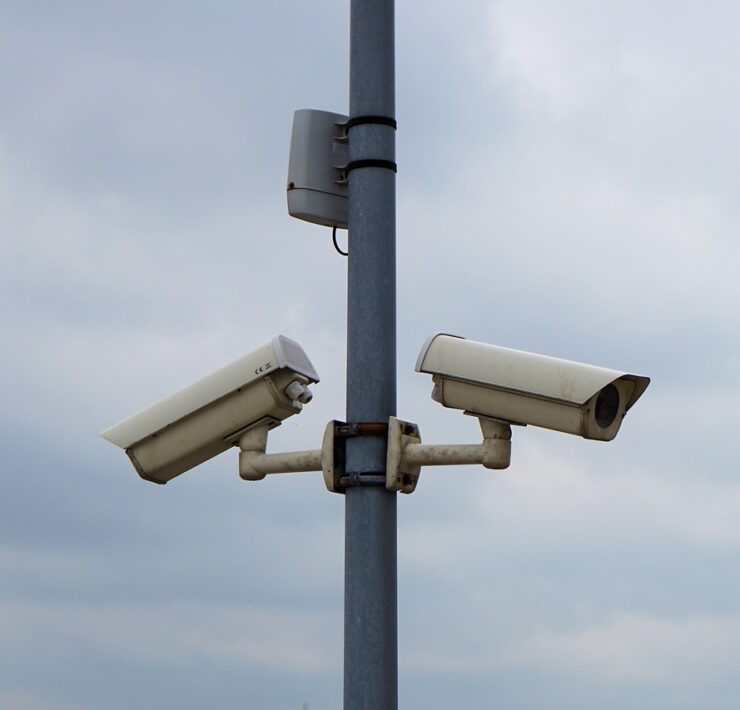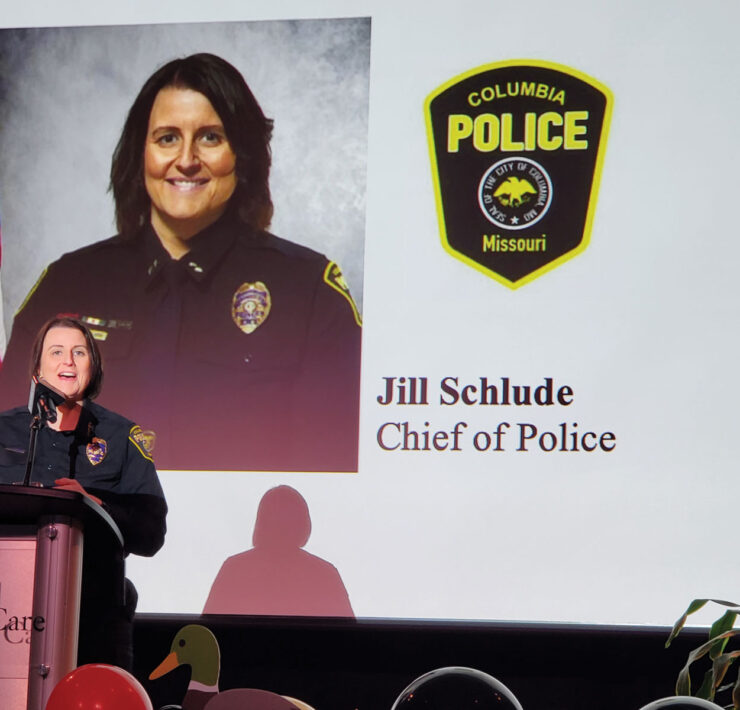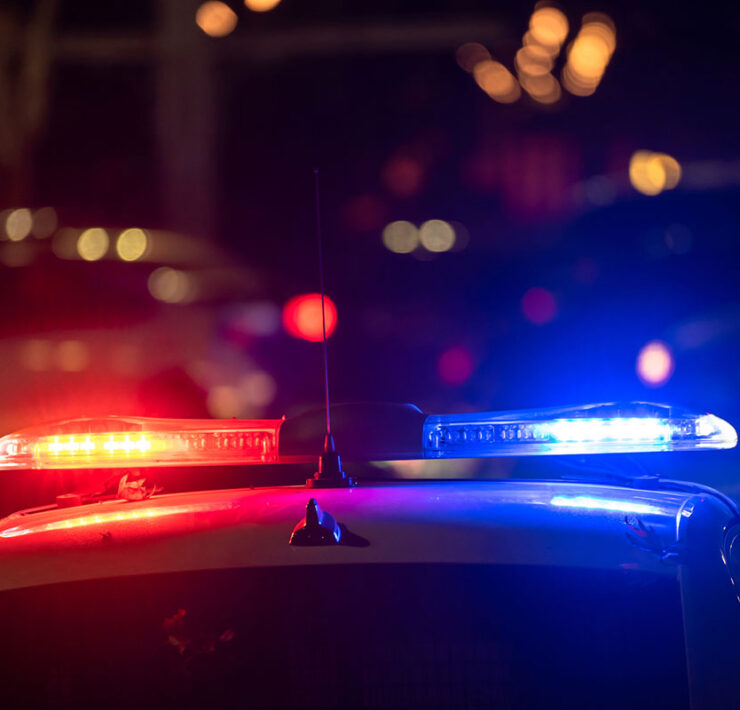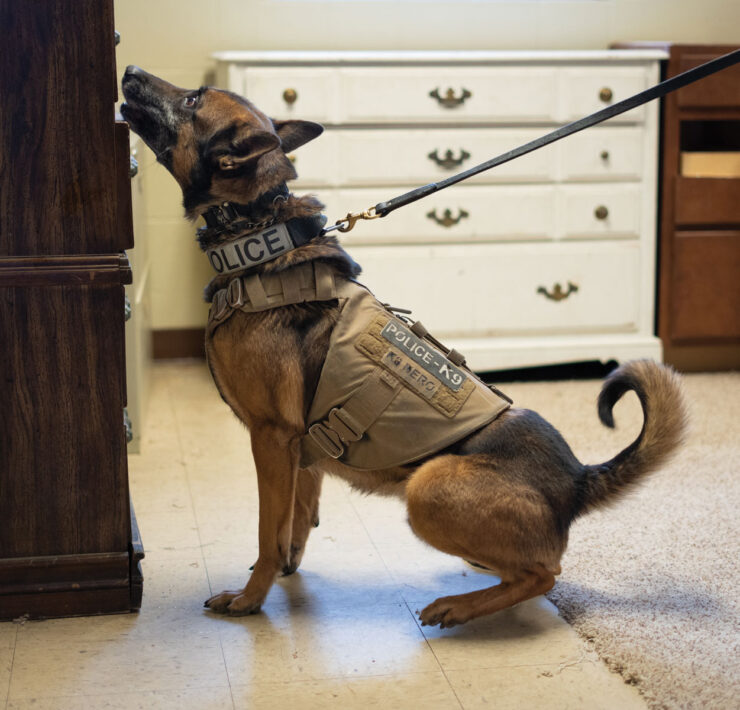Race and the Columbia Police Department
On Aug. 9, 2014, 18-year-old Mike Brown was fatally shot by Ferguson police officer Darren Wilson, igniting the city into a weeklong riot. During the riot, police had suppressed agitated protesters through various crowd-control tactics: tear gas, rubber bullets, beanbag rounds. Some protesters fired gunshots; several stores had been looted. Police donned heavy armor to protect themselves from bottles and rocks hurled toward them.
Nearly two weeks later and 116.7 miles westward, an estimated 400 mid-Missouri residents staged a protest at Boone County Courthouse. It was bright and hot outside. Uniformed Columbia Police Department officers passed out water from coolers, while plain-clothed officers blended in with the crowd as they chanted and cheered.
The protest was one of four to occur in Columbia in response to the event that ignited racial ten- sion with law enforcement in St. Louis — the event that sparked a national debate about race, rights and law enforcement. Although not mired in crisis, Columbia would still host discussions and debates on the events in Ferguson and what it might mean for our own city.
“The death of Mike Brown and similar cases around the nation regarding police-related fatalities of black men have heightened the awareness of the issues of race that still persist in America,” says Hickman High School principal Eric Johnson. “Columbia is not excused from that conversation.”
“The first step in solving any issue is bringing it to the forefront,” Johnson adds. He addressed students the day after the decision not to indict Darren Wilson was announced. “Talking about race without making it seem like a taboo topic that can’t be addressed goes a long way. Ignoring it is far worse than addressing it.”
The ‘trust gap’
When the verdict not to indict Darren Wilson was read on Nov. 24, Missouri’s NAACP president, Mary Ratliff, upheld the plans she’d made days prior. The NAACP would not support “renegade protests,” as she called them. They would meet the following day at Second Baptist Church and prepare people to demonstrate without violence.
By this point, Ratliff, a resident of Columbia, had already spoken to Columbia Police Department Chief Ken Burton a number of times, starting with that pro- test in august. although no one can know for certain why Columbia remained relatively calm, there are a lot of guesses.
“The reason there wasn’t rioting here is because we’ve been working for the past 16 months to find recommendations to violence and diving into all aspects of the relationship between the police and the community,” says Tyree Byndom, a member of the Mayor’s Task Force on Violence, which was established in August 2013.
Columbia was an early adopter of a police review board, establishing the nine-member board in 2009. In 2009, Burton established the public relations department to increase department visibility. Body cameras were introduced for the Downtown Unit in 2010, before they were a politically savvy item, and last July the department was the first in Missouri to implement them for all units.
Despite a department that appears to be keenly aware of the issues surrounding modern policing, the task force’s report still noticed that community/police trust issues were “a very clear theme.” The report reads, “The ‘trust gap’ between the African American community and police needs to be aggressively addressed by the police department and the community.” From there, the report outlines how this trust might be the most cost-effective way to solve and prevent crime in Columbia.
Mike Hayes, a retired CPD officer and member of the Mayor’s Task Force on violence, has high hopes for the report.
“I’m confident that [City Council] will do some- thing with it,” he says. “I hope they don’t prove me wrong and just put it on a shelf somewhere. It was brought to my attention that they’d done this before under a different mayor, I think in the ’80s or ’90s…I hope it doesn’t become a reoccurring thing.”
According to Assistant Chief of Patrol John Gordon and Assistant Chief of Investigations Jeremiah Hunter with the CPD, in order for those task force recommendations to work, it’s important that they be prioritized to account for CPD’s current resources.
The CPD saw change as a result of what happened in Ferguson. Some was good; communications between the Police Department and black residents of Columbia improved through conscious outreach efforts, according to Gordon and Hunter. More residents made the extra effort to thank officers for their service.
On the other hand, Hunter and Gordon have seen a glut of anti-police graffiti downtown, “some that says, point-blank, to kill us.” Since Ferguson, Hunter and Gordon have also given officers more freedom to choose when to pair up for patrols.
“When you’ve been a cop for a while, you can kind of feel it when it might be a bad night,” Gordon says. “I think you’re always one step away from a situation becoming something like Ferguson.”
“One incident, one shooting,” Hunter adds. “One misconstrued action.”
‘We’re still little Dixie, but With a paint job’
In its early years, Columbia was the primary city of a swath of land along the Missouri River dominated by slave-holding families. This cluster of counties was known as Little Dixie. Today, race is divided most obviously by Broadway. One-third of the population in the area bound by Broadway, Stadium Boulevard, I-70 and College avenue is black. Throughout Columbia, only 11 percent of residents are African American, according to census data aggregated by city-data.com.
“Columbia was called Little Dixie for a reason,” says William “Gene” Robertson. “Some may deny it, but today, we’re still Little Dixie, but with a paint job. There are still all sorts of divisions and hierarchies.”
Robertson was the second black professor at the University of Missouri. He was hired just three years after the first, Arvarh Strickland. He taught urban planning and community and organizational development. To this day, Robertson writes about race for the Columbia Missourian.
“Police outcomes — the whole judicial system — just reflect the value system Columbia formerly had,” he says.
The outcomes Robertson mentions include the increased rate at which African Americans are stopped by police (2.29 to 0.91 for Caucasians). That number is higher in Columbia’s surrounding communities, between 2.46 in Centralia and 12.68 in Hallsville.
Gordon with the CPD says this has more to do with crime statistics than it does with race. “In the areas that ask for our services the most, part of the policing method is to stop cars and find out who’s coming in and out of the area,” he says. “Of our hard crime areas, the majority of them are low-income areas that contain African Americans.” Robertson attributes unbalanced racial outcomes to deep-rooted stereotypes: the ones that rarely surface in controlled situations.
“If you gave police officers a test, they’d express their feelings intellectually,” Robertson says. Despite his position as an 80-year-old professor emeritus at MU, Robertson says even he “gets ready to have a crisis experience” when he sees red and blue lights in his rear- view mirror.
“What the black community sees on the surface is a disproportionate number of arrests,” says Johnson at Hickman. “They feel the sting of microaggressions when eyes follow them around, and they feel the discomfort of ‘knowing’ other people prejudicially question their intentions.”
“Even I, the principal of a high school, am not excused from the microaggressions that plague the lives of black people,” he continues. “This is not just a law enforcement concern in Columbia. It is a concern of social inequity nationwide.”
Others, such as Devont’e Daniels, a young black man who lives in north Columbia, feel the need to record their interactions with police officers on cellphones. Black youth in Columbia have a mantra: “Free the town.” The mantra is directly related to African Americans’ experience with the judicial system, Byndom says.
“It’s going to take a lot of work to make African Americans less suspicious of the Police Department,” Ratliff says. Perhaps Byndom sums it up best.
“Because the relationship is so frayed, it’s more difficult to come to resolutions that are good for both sides,” he says.
Community policing, a bigger price tag
Around 15 years ago, the CPD began a community policing campaign. Community policing is the act of allocating police officers to particular areas so they become familiar with the local inhabitants.
According to Hayes, the idea of community policing was active in Columbia long before then.
“We even had community policing when I was a kid growing up in Columbia, only we didn’t call it that,” he says.
When the formal community policing initiative began 15 years ago, Hayes says there were enough officers per capita to sustain those efforts.
“Now they’re just going from call to call,” he says. “They’re so busy.”
In 2000, there were 1.5 officers per 1,000 people. In 2014, there were 1.42 officers for every 1,000 residents, according to CPD Uniform Crime Reporting data. Since authorized strength per 1,000 has been recorded (2000), the highest it has been was 1.59 per 1,000 in 2002, 2003, 2005 and 2006. The lowest it has been was 1.4 in 2013.
In 2003, the earliest year for which call volume was recorded in the UCR data, each officer answered around 482 calls for service, compared to almost 478 in 2014.
Then, two years ago the CPD assigned two officers to the Douglass Park area to practice only community policing. The results were so positive that despite criticism from time- strapped police officers, Burton decided to continue community policing in the Douglass Park area.
Ultimately, that was the goal when the CPD aimed for funding for 50.8 new cops in last November’s ballot initiative, which failed.
To effectively institute community policing throughout Columbia, Burton says his officers would need to set aside one-third of their time for “discretionary activities,” such as community policing.
“Right now they spend half their time responding to calls and the other half doing administrative work resulting from those calls,” he says. “Right now, we’re having to be reactive instead of proactive.”
“Our core responsibilities are to respond to calls for service and to investigate crime,” Gordon says.
The pair of officers in Douglass Park have 100 percent discretionary time — they don’t respond to calls. Officers Jameson Dowler and Andy Meyer, known as Starsky and Hutch in their beat, play baseball with kids in the park and are on a first-name basis with residents in the area. The residents even threw one of the officers a birthday party at the park.
The Downtown Unit is another example of community policing.
According to Ratliff, community support for the finances required for community policing is stuck in a chicken-or- the-egg dilemma.
“There are a lot of citizens who want [the CPD] to show us they’ll do things bet- ter, and then maybe we’ll support more police officers,” she says.
Gordon says the chief put it best.
“He said, ‘The citizens of Columbia will choose what type of law enforcement they want for this community,’” Gordon says. “If they want plan a, it’s going to cost this much, and so on.” Community policing just comes with a bigger price tag.
Johnson recalls experiencing community policing when he grew up in inner city Kansas City. He thinks resolving the issue will require at least three steps: approach the problem with honesty, participate in practices that restore relationships and community rather than punitive practices, and hire more minority police officers.
“Although it will not automatically improve relationships, I think having individuals who can speak to the experience of underserved minority groups who are overrepresented in the legal system can impact community perception to a certain extent,” he says.
Six percent of CPD’s officers are black, compared to 11.3 percent of Columbia’s population, according to the 2010 census. Burton says the department isn’t seeing many applications from African Americans. Ratliff attributes this to african americans feeling as though police officers are more suspicious.
“And they don’t want to be a part of that,” she says.
To address this, the Police Department plans to recruit at historically black universities. and though there have been informal conversations about methods to develop an interest in local black youth to become police officers, no formal plans have been made.
Hayes says most officers in his day had previous inroads to the police force. They didn’t just “decide one day” they wanted to be a police officer. For him, his first inroad was being a part of a baseball team sponsored by the CPD.
“I would bet that the [school resource officers] and Starsky and Hutch have helped,” Burton says.
Up for review
The final trust-related recommendation from the task force calls for “greater public involvement and accountability.”
Columbia first established a police review board in 2009. In February, a St. Louis city committee approved a civilian police review board, though a final vote isn’t expected until august.
Steve Weinberg, a professor emeritus of the Missouri School of Journalism and widely published author of articles and books, many pertaining to the criminal justice system, was appointed to the first review board.
“A lot of people in Columbia, especially African Americans, did not trust the police in town,” he says. “The cases we got weren’t all from African Americans, but most of them were.”
The most memorable case for Weinberg was a use-of-force case, where six of the nine members of the review board disagreed with Burton’s decision that the use of force was not excessive.
Despite that majority, Burton did not change his mind even after the review board took its decision to the city manager. It was one of two cases Weinberg can recall during his tenure that made it to the city manager’s desk.
Following the decision, Weinberg attended a police union meeting in an attempt to explain the board’s decision.
“The attitude of the police officers I’d encountered while on the board was, ‘How dare you people on this police review board second-guess us,’” Weinberg says.
The most common complaint from police officers that Weinberg can recall was that the officers didn’t want to have to think about potential repercussions from the review board when they’re making time-sensitive decisions in the field. another concern was that those on the board wouldn’t understand the inner workings of law enforcement.
“My concern with the review board was that we were going to be judged by someone with no training or that we might be considered guilty until proven innocent,” Hayes says.
Burton says he doesn’t think Columbia needs a police review board.
“In reality, I don’t think they’ve got a lot to do,” he says. “But if the citizens think we need it, then we need it.”
Burton says there were only a couple complaints last year.
Andrew Fisher, a graduate sociology student at MU, has studied the relationship between minority communities and the police. He also serves on the police review board in Columbia. He was appointed in 2012.
“Since I’ve been on the board, we haven’t had a flurry of complaints,” Fisher says. “There isn’t a stark notice of, ‘Oh, it’s a certain race or certain class complaining about police.’”
“The reason the board is bored is because we’re taking care of our complaints internally,” Burton says. He credits this to a more proactive approach to discipline. The CPD’s policies have been reviewed and streamlined, though he still allows room for police discretion.
“Police officers like bright-line rules: always do this, never do that,” Burton says. “In reality, it’s not that easy.” He recounts an officer who pulled over an 80-year-old woman at 2 p.m. on a Tuesday. She’d forgotten to pay a $25 citation, and the officer handcuffed her and put her in the back of the squad car.
“That was policy, but that’s not what I wanted him to do in that situation,” Burton says. “He might have asked the woman to park and lock her car and taken her in the front seat of the squad care and directly to the judge. I want our officers to do the right thing, at the right time, for the right reason.”
“If you are on patrol one night, and you need to hit someone in the head with a brick — whatever you need to do to go home at the end of your shift — you need to do,” he says. “Sometimes it’s not going to be in policy, but if you can tell me why you needed to do it, and the reason is valid, that’s OK. You have a lot, a lot of discretion out there.”
However, that’s not a sentiment all share. From some perspectives, more needs to be done. Byndom recalls an instance when he was pulled over.
“[The officer] was like, ‘Shots have been fired,’ and he was acting very secretive and scared,” he says. “How can you do your job when you’re so scared? You’re going to make mistakes,” mentioning his service in the Marine Corp.
“It’s not your job to make sure you get home,” he says. “It’s your job to protect and serve. If you’re fearful, you need to get a new job.”
Chipping away at the ‘blue shield of silence’
Chief Burton came to Columbia in 2009 from Arlington, Texas. Shortly after he took office, the CPD was involved in the Whitworth SWAT raid, in which officers ran a search warrant at a home and shot two dogs.
One of Burton’s policies is “when you’re wrong, admit it.” and so he did, addressing and implementing policy changes following that raid.
“I got some criticism for saying we shouldn’t have run that warrant the way we did,” Burton says. “Internally, they said, ‘We’ve always run them that way,’ and I said, ‘Well, we’re not running them that way anymore.’”
He faced another onslaught of public criticism from his officers in 2011, after he fired an officer for use of excessive force.
Ratliff with the NAACP can recall one very powerful moment in the case, when Burton pulled out a big box of complaints against that officer.
“Burton has done better than any other police chief I’ve worked with,” says Ratliff, who has been president of the Missouri NAACP since 1991. She thinks Burton is slowly chipping away at what she calls “the blue shield of silence.”
Robertson agrees. He thinks Burton has been “a possible ray of hope” to address these issues.
“There are a lot of things that the department can reassess to do things better,” Gordon says. “Don’t judge the Columbia Police Department on their past actions. Judge them on their current actions.”
A community divided
Columbia has always been somewhat divided into “resident” and “student” categories. according to MU 4 Mike Brown’s student leader, Naomi Daugherty, this divide has also resulted in an activism gap in response to Ferguson’s events.
“Part of it is that we were fighting for different things,” she says. “a lot of the MU 4 Mike Brown initiative was for policy change within the university. I also think part of it is Mizzou students not having the resources to reach out to the community. … I can’t help you if I don’t know what your problem is.”
“There is, I think, a lack of conversation about race relations in Columbia,” Fisher says. “It’s just not there, for whatever reason, you know, so I think it’s lacking these kinds of dynamics.”
Robertson agrees. He’s been in Columbia long enough to identify trends. although he says Columbia’s black residents used to have common avenues to discuss cur- rent issues facing the community — T & H Restaurant stands out in his mind — he says that’s no longer the case.
“People only really want to have these celebrations and parades, for MLK Day or whatever,” he says. But socioeconomic fractionalization, he says, has divided the black community in Columbia.
“I have a friend,” he says, “who called me after a black man shot someone. He asks me, ‘How does that make us look?’ and I told him, ‘It doesn’t make you look any different.’”
“It’s human instinct to clump a group of people into one category,” Hayes says. He’s not talking about African Americans, though. He’s talking about police officers. “I think there’s a stereotype now. But the police aren’t there to hurt you; they’re there to preserve safety.”
“There’s going to be a certain percentage that no matter what you say or do have a negative view,” Hayes continues. “Then you have the majority who don’t base their opinions on a single interaction. They don’t lump all police officers into one group.” although he’s talking about community stereotypes of police officers, it’s a statement that can be more widely applied.
‘It’s better than not fighting at all’
On the night the decision was made not to indict Darren Wilson, MU 4 Mike Brown marched on City Hall. Daugherty recalls members of the community streaming out to join them. The gathering featured impromptu chanting and speeches, including one made by a child Daugherty estimated to be about 4 years old. It was a crystallizing moment for her.
“That was the moment I was sure I would not see the true effects of this in my lifetime,” she says. “I think that’s when I realized that this is going to be a lifelong struggle, but it’s better than not fighting at all.”








